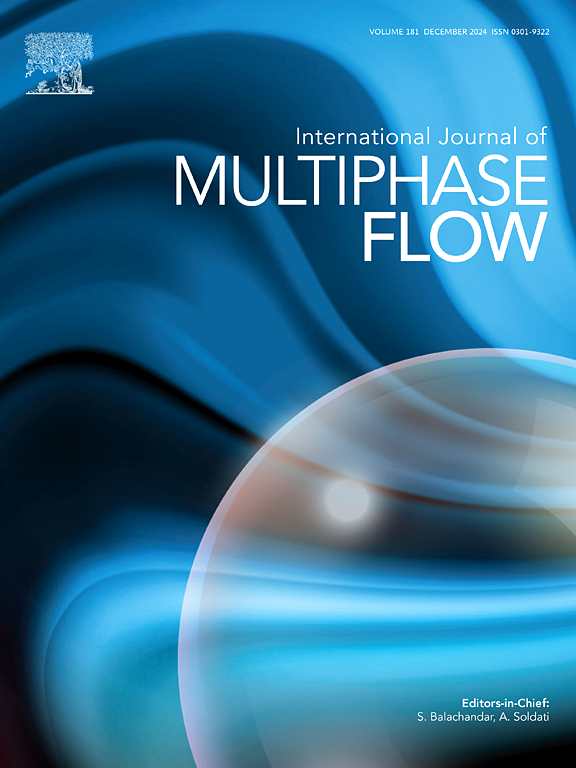微交叉通道中液滴的捕获和聚并
IF 3.8
2区 工程技术
Q1 MECHANICS
International Journal of Multiphase Flow
Pub Date : 2025-09-17
DOI:10.1016/j.ijmultiphaseflow.2025.105454
引用次数: 0
摘要
微流体控制液滴动力学在十字形通道中具有重要的工业应用潜力。本研究系统研究了水包油乳液在微流控十字通道中的液滴动力学,揭示了涡旋击破驱动的液滴捕获与聚并耦合机制,重点研究了雷诺数(Re)在50-350范围内界面张力降低的调控作用。结果表明,对称捕集、液滴链捕集和轴向旋转三种捕集模式受流型演化的控制。表面活性剂的加入将捕获开始的临界Re从90提高到120,界面张力的降低增强了捕获液滴的稳定性。表面活性剂浓度的增加显著抑制了液滴振荡频率和聚结频率,同时显著延长了排膜时间。此外,基于经典的膜排水模型,我们开发了一个修正的聚结模型,该模型包含表面活性剂浓度依赖的界面输运性质,将聚结时间预测误差限制在30%以内。本文章由计算机程序翻译,如有差异,请以英文原文为准。

Trapping and coalescence of droplets in micro cross-shaped channels
Microfluidic manipulation of droplet dynamics in cross-shaped channels presents significant potential for industrial applications. This study systematically investigates the droplet dynamics of oil-in-water emulsions in microfluidic cross-shaped channels, revealing a coupled mechanism of droplet capture and coalescence driven by vortex breakdown, focusing on the regulatory effects of interfacial tension reduction within the Reynolds number (Re) range of 50-350. The results show that three capture patterns, i.e., symmetric trapping, droplet chain capture, and axial rotation are controlled by the evolution of flow regimes. Surfactant addition significantly raises the critical Re for trapping onset from 90 to 120, with interfacial tension reduction enhancing trapped droplet stability. Increasing surfactant concentration significantly suppresses droplet oscillation frequency and coalescence frequency, while substantially prolonging film drainage time. In addition, based on classical film drainage models, we develop a revised coalescence model incorporating surfactant concentration dependent interfacial transport properties that limits coalescence time prediction errors to within 30 %.
求助全文
通过发布文献求助,成功后即可免费获取论文全文。
去求助
来源期刊
CiteScore
7.30
自引率
10.50%
发文量
244
审稿时长
4 months
期刊介绍:
The International Journal of Multiphase Flow publishes analytical, numerical and experimental articles of lasting interest. The scope of the journal includes all aspects of mass, momentum and energy exchange phenomena among different phases such as occur in disperse flows, gas–liquid and liquid–liquid flows, flows in porous media, boiling, granular flows and others.
The journal publishes full papers, brief communications and conference announcements.

 求助内容:
求助内容: 应助结果提醒方式:
应助结果提醒方式:


